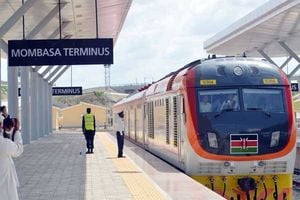
A standard gauge railway steward attends to a passenger at the Nairobi terminus Syokimau on August 14, 2024.
The management and operation of railways in Kenya is in the spotlight as two clashing Bills jostle to reform the critical sector in the transport ecosystem.
At the centre of the fight to restructure the railway transport is the National Transport and Safety Authority (Amendment) Bill 2024 and the Railways Bill 2024.
The NTSA Bill, sponsored by Limuru MP John Kiragu, has already been published and is under consideration in the National Assembly.
The Railways Bill, though still in draft form, is sponsored by the Ministry of Roads and Transport.
The ministry has already placed advertisements inviting Kenyans for comments and public participation to be undertaken in all the 47 counties from August 26, 2024 to September 13, 2024, before it is formally published and tabled in Parliament.
“The Ministry and the Kenya Railways Corporation notifies stakeholders and members of the public that it has developed the Railways Bill that aims at enhancing effectiveness and efficiency in provision of services and operations in the railway sector by providing open access to railway infrastructure for operation,” the notice placed in the dailies reads.
Kenya Railways Corporation Act
Kenyans have until August 23, 2024 to submit their views.
The Bill seeks to repeal the Kenya Railways Corporation Act and replace it with the Railways Act that will establish the Kenya Railways Corporation (KRC) and Railway Regulatory Authority (RRA) as the railway economic and safety regulator.
The NTSA Bill seeks to amend section 4 of the NTSA Act to introduce new paragraphs that includes coordination of transport safety and undertaking investigations on accidents relating to aircraft, road, railway, marine within the Kenyan waters, pipeline in which there is a fatality or substantial property damage.
This also includes other accidents relating to the transportation of people or property “which in the opinion of NTSA” is catastrophic or involves problems of a recurring character and recommend actions or measures to be undertaken to avoid occurrences of accidents in future.
In so doing, the Bill assigns NTSA the onus of safeguarding land transportation safety and “making appropriate recommendations to forestall future occurrence of such accidents.”
This includes determining the facts, conditions, circumstances and safety factors “and where possible the probable cause of the accident with the sole objective of prevention of future accidents and incidents and not to apportion blame or liability.”
“The Bill seeks to have an integrated and unified approach towards regulation of safety of various modes of transportation unlike the current fragmented approach where different regulatory agencies regulate different modes of transportation in order to promote transportation safety and enhance transportation efficiency,” the Bill reads.









